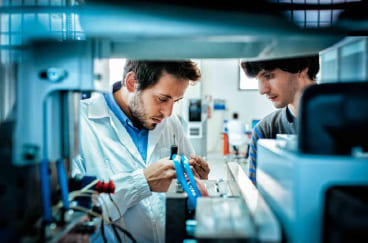Local fiber alignment in fiber-reinforced thermoplastics is governed by complex flows during the molding process. As fiber-induced material anisotropy leads to non homogeneous effective mechanical properties, accurate prediction of the final orientation state is critical for integrated structural simulations of these composites. In this work, a data-driven inverse modeling approach is proposed to improve the physics-based structural simulation of short glass fiber reinforced thermoplastics. The approach is divided into two steps: (1) optimization of the fiber orientation distribution (FOD) predicted by the Reduce Strain Closure (RSC) model, and (2) identification of the composite’s mechanical properties used in the Ramberg–Osgood (RO) multiscale structural model. In both steps, the identification of the model’s parameters was carried out using a Genetic Algorithm. Artificial Neural Networks were used as a machine learning-based surrogate model to approximate the simulation results locally and reduce the computational time.
X-ray micro-computed tomography and tensile tests were used to acquire the FOD and mechanical data, respectively. The optimized parameters were then used to simulate a tensile test for a specimen injection molded in a dumbbell-shaped cavity selected as a case study for validation. The FOD prediction error was reduced by 51% using the RSC optimized coefficients if compared with the default coefficients of the RSC model. The proposed data-driven approach, which calculates both the RSC coefficients and the RO parameters by inverse modeling from experimental data, allowed improvement in the prediction accuracy by 43% for the elastic modulus and 59% for the tensile strength, compared with the non-optimized analysis.
In this work, the identification of the RSC model coefficients was carried out using a Genetic Algorithm (GA), which can escape local optima through mutation. In order to reduce the computational time, Artificial Neural Networks (ANN) were used as a machine learning-based surrogate model to approximate the simulation results locally. Injection molding simulations and _CT scans were used to identify and compare the FOD Materials 2022, 15, 4720 3 of 16 at different locations of an injection-molded plate made of polyphenylene sulfide (PPS). The optimized FOD predictions were then translated into local mechanical properties, using tensile specimens cut out from the plate at different angles. The optimized coefficients were then used to simulate a tensile test for a specimen injection molded in a dumbbellshaped cavity. Numerical and experimental results (obtained from both _CT scans and mechanical characterization of the injection-molded specimens) were eventually compared to assess the impact of the proposed data-driven approach on the accuracy of the mechanical behavior prediction.
